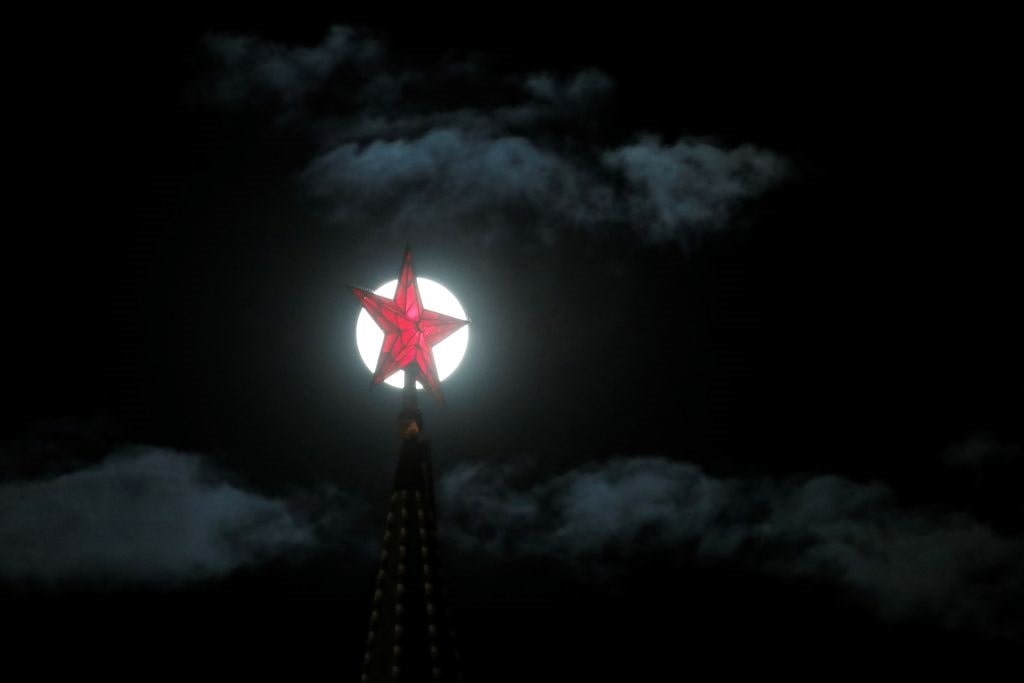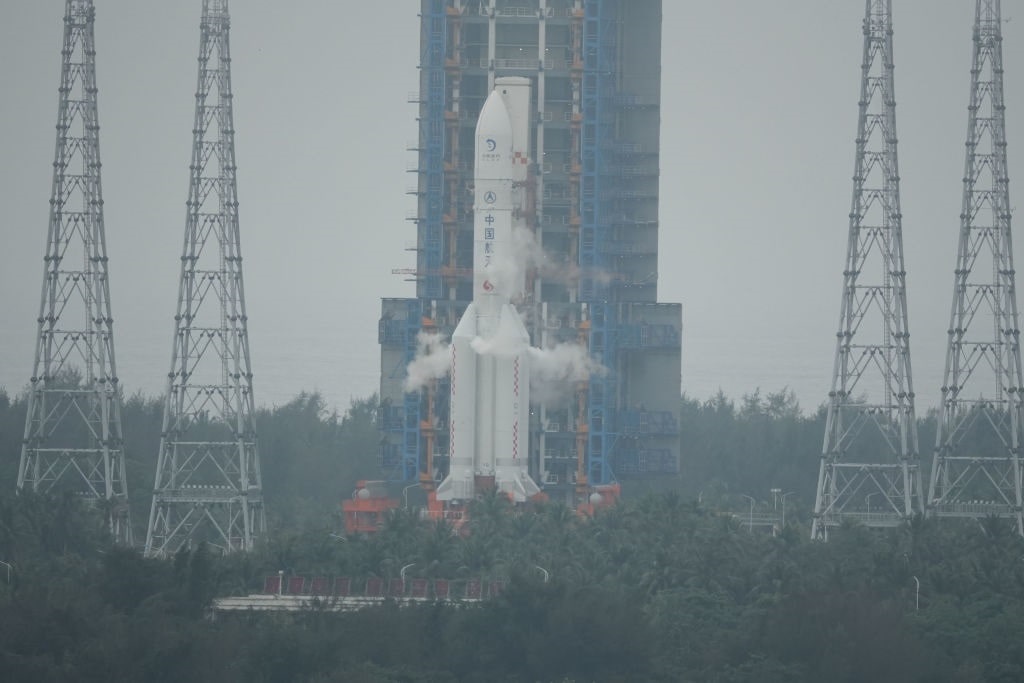The Beijing-Moscow collaboration presents the US with challenges in space not faced before.
By | May 13, 2024 @ Liberty Nation News Tags:Articles, Good Reads, Military Affairs, Opinion

The United States will have to up its space exploration game, it seems. As Space X and the National Aeronautics and Space Administration (NASA) move methodically toward a manned moon landing, Russia and China plan an extravagant lunar presence of their own. Russia is building a nuclear facility to power its science and research community stationed on the moon. Such announcements do not suggest that the US is behind in the race to colonize our celestial satellite, but it should motivate NASA and Space X to move up their timetable for manned landings. Another concern that should get US space program officials’ attention is the historic hegemonic aspirations of Beijing that could extend to claiming large areas of the lunar surface for its military purposes.
 Russia’s attempt last August
at a soft landing on the moon’s southern pole failed during the
orbit-to-landing transition phase of the mission. “Luna-25 was to be the
first soft landing on the Moon’s South Pole. However, the anticipated
year-long lunar-surface exploration was cut short before it began,” Liberty Nation
observed. Though it is unlikely Russia will abandon its unilateral
lunar exploration program, the recent close relationship between Russian
President Vladimir Putin and China’s President Xi Jinping includes a
collaboration on space programs.
Russia’s attempt last August
at a soft landing on the moon’s southern pole failed during the
orbit-to-landing transition phase of the mission. “Luna-25 was to be the
first soft landing on the Moon’s South Pole. However, the anticipated
year-long lunar-surface exploration was cut short before it began,” Liberty Nation
observed. Though it is unlikely Russia will abandon its unilateral
lunar exploration program, the recent close relationship between Russian
President Vladimir Putin and China’s President Xi Jinping includes a
collaboration on space programs.
Russia and China are partnering in developing a lunar research complex. “The two countries are collaborating on the International Lunar Research Station, a massive complex on the Moon that is set to break ground in 2026,” the Daily Mail explained. “The proposed base, which will have a radius of nearly four miles, larger than any Disney theme park, will house scientists who will study the Moon’s properties.”
Russia Plans Nuclear Power Plant for the Moon
Russia’s contribution to the lunar megaplex will be a nuclear power facility to ensure reliable power for the inhabitants and the running of scientific equipment on the moon station. China’s lunar landing program has been moving steadily, with a note-worthy soft landing on the far side of the moon in January 2019. China launched the Chang’e-4 spacecraft “on 8 December 2018 from the Xichang Satellite Launch Center in Sichuan province,” according to Science magazine. “The landing site is in the Von Kármán crater in the South Pole-Aitken Basin.” Beijing’s lunar mission was significant because it coordinated an earlier launch of a communications satellite to orbit the moon to retransmit signals from the Chang’e-4 to Earth. A satellite is required because the moon blocks line-of-sight communications from the far side.

Chang’e-6 probe (Photo by Costfoto/NurPhoto via Getty Images)
On May 3, 2024, China launched the Chang’e-6 lunar mission atop a Long March 5 rocket to the far side of the moon that, if successful, will collect lunar surface samples and return them to Earth. The predecessor to the recent launch, Chang’e-5, made the trip to the moon in 2020, retrieved about four pounds of dust material from the surface, and returned the samples to Earth. The Chang’e-6 mission’s lunar orbiter “will circle the Moon while its lander descends into the 1,616-mile-wide South Pole-Aitken basin on the lunar surface. The impact that created the basin – among the largest in the history of the solar system – is thought to have dug up material from the lunar mantle,” The New York Times reported.
Though the scientific research from these Chinese missions could be valuable, the intentions of China ultimately are unclear. Any partnership between Russia and China is potentially a problem for the US. Statements made by Chinese officials portend motives more sinister than research. As the Daily Mail reported:
“China also announced it was planning on installing an all-seeing surveillance system on the Moon to protect a planned lunar base…The nation wants to use the ‘successful experience’ of its authoritarian Skynet surveillance system to protect the planned base against ‘suspicious targets’, according to a research paper written by scientists at the nation’s space agency that was published in an academic journal.”
There is an ulterior motive behind the Sino-Russian sprint to the Moon. There are rare elements believed to be on the Moon in amounts far more abundant than on Earth. In a space exploration game of finders-keepers, the US cannot be on the losing side. Some estimates of the value of lunar resources could be as much as $1,000,000,000,000,000 – that’s a quadrillion dollars. For example, Hellium-3 is a stable, very light isotope of helium and very rare on Earth. Helium-3 is important in running nuclear power plants. “It is essential to mention that 2.2 pounds, or 1 kilogram of Helium-3 mixed with 1.5 pounds, or 0.67 kilograms of deuterium can produce 19 years of megawatt energy— enough power to run the United States for a whole year,” an article published in the 2022 Lunar Surface Science Workshop 18 reported.
The US Artemis Space Program Is Progressing
The United States’ space program has not been idle. The Artemis space exploration program is moving forward. NASA launched an unmanned but representative Orion space capsule on a 1.4-million-mile voyage to the Moon, making several elliptical orbits and, “performing a deep space profile and taking a man-capable spacecraft further than any previous space flight,” Liberty Nation reported.
NASA plans three additional Artemis missions, culminating with a manned landing during the Artemis III mission in 2026 and Artemis IV, where astronauts will establish the first space station orbiting the moon. “Artemis IV will live and work in humanity’s first lunar space station, Gateway, which will enable new opportunities for science and preparation for human missions to Mars,” NASA explained.
The Sino-Russian team formed for lunar exploration has an aggressive schedule for exploiting lunar research opportunities and potential military purposes. For the US, the challenge is simply getting there first. Only 12 humans have ever walked on the moon. All of them were Americans. It seems like a worthy trend to preserve.
The views expressed are those of the author and not of any other affiliate.
No comments:
Post a Comment